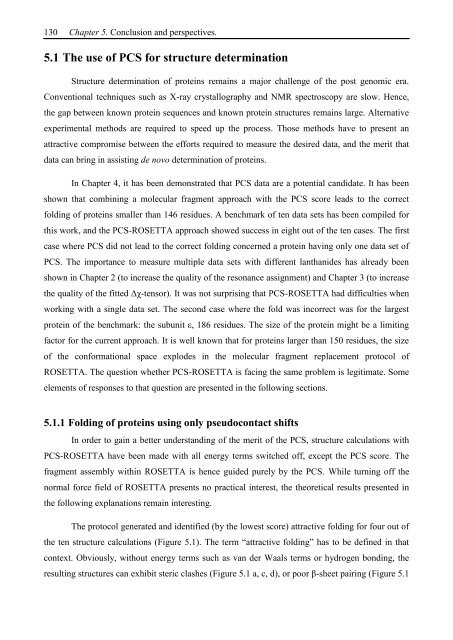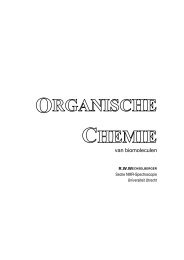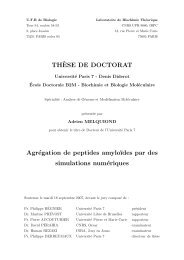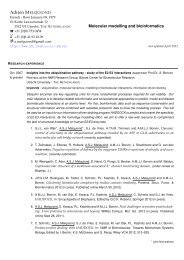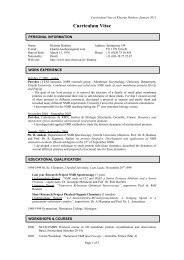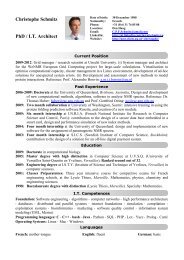Thesis Title: Subtitle - NMR Spectroscopy Research Group
Thesis Title: Subtitle - NMR Spectroscopy Research Group
Thesis Title: Subtitle - NMR Spectroscopy Research Group
Create successful ePaper yourself
Turn your PDF publications into a flip-book with our unique Google optimized e-Paper software.
130 Chapter 5. Conclusion and perspectives.<br />
5.1 The use of PCS for structure determination<br />
Structure determination of proteins remains a major challenge of the post genomic era.<br />
Conventional techniques such as X-ray crystallography and <strong>NMR</strong> spectroscopy are slow. Hence,<br />
the gap between known protein sequences and known protein structures remains large. Alternative<br />
experimental methods are required to speed up the process. Those methods have to present an<br />
attractive compromise between the efforts required to measure the desired data, and the merit that<br />
data can bring in assisting de novo determination of proteins.<br />
In Chapter 4, it has been demonstrated that PCS data are a potential candidate. It has been<br />
shown that combining a molecular fragment approach with the PCS score leads to the correct<br />
folding of proteins smaller than 146 residues. A benchmark of ten data sets has been compiled for<br />
this work, and the PCS-ROSETTA approach showed success in eight out of the ten cases. The first<br />
case where PCS did not lead to the correct folding concerned a protein having only one data set of<br />
PCS. The importance to measure multiple data sets with different lanthanides has already been<br />
shown in Chapter 2 (to increase the quality of the resonance assignment) and Chapter 3 (to increase<br />
the quality of the fitted Δχ-tensor). It was not surprising that PCS-ROSETTA had difficulties when<br />
working with a single data set. The second case where the fold was incorrect was for the largest<br />
protein of the benchmark: the subunit ε, 186 residues. The size of the protein might be a limiting<br />
factor for the current approach. It is well known that for proteins larger than 150 residues, the size<br />
of the conformational space explodes in the molecular fragment replacement protocol of<br />
ROSETTA. The question whether PCS-ROSETTA is facing the same problem is legitimate. Some<br />
elements of responses to that question are presented in the following sections.<br />
5.1.1 Folding of proteins using only pseudocontact shifts<br />
In order to gain a better understanding of the merit of the PCS, structure calculations with<br />
PCS-ROSETTA have been made with all energy terms switched off, except the PCS score. The<br />
fragment assembly within ROSETTA is hence guided purely by the PCS. While turning off the<br />
normal force field of ROSETTA presents no practical interest, the theoretical results presented in<br />
the following explanations remain interesting.<br />
The protocol generated and identified (by the lowest score) attractive folding for four out of<br />
the ten structure calculations (Figure 5.1). The term ―attractive folding‖ has to be defined in that<br />
context. Obviously, without energy terms such as van der Waals terms or hydrogen bonding, the<br />
resulting structures can exhibit steric clashes (Figure 5.1 a, c, d), or poor β-sheet pairing (Figure 5.1


